
Pharmacokinetic-pharmacodynamic approach permits vancomycin dose adjustment for drug effectiveness against infections caused by gram-positive pathogens MIC >1mg/L in ICU pediatric burn patients
Introdução: Os pacientes sépticos pediátricos em terapia intensiva evidenciam alterações na farmacocinética da vancomicina durante as infecções graves causadas por Gram-positivos susceptíveis. O regime de dose para garantir a efetividade representa um grande desafio para a equipe médica, uma vez que a dose recomendada atinge o alvo contra patógenos até CIM <1 mg/L. Objetivo: O racional neste estudo foi realizar a dosagem sérica da vancomicina seguida da abordagem PK/PD em tempo real, para avaliação da efetividade do antimicrobiano em pediátricos sépticos queimados.
Métodos: 20 pacientes sépticos grandes queimados com função renal preservada 6F/14M foram investigados. As características: 5.0(3.0-9.0) anos, 22(16-38) kg, 30(20-39) % superfície corpórea total queimada, CLcr 240(201-295) ml/min, medianas (interquartil). O fogo foi o agente da queimadura; a lesão inalatória ocorreu em 12/20 pacientes; os vasopressores e a ventilação mecânica foram exigidos em 13/20. A terapia empírica 10-15mg/kg q6h, infusão 1h. As culturas foram coletadas antes do início da terapia antimicrobiana. Amostras de sangue (1,5 mL/cada) foram coletadas após a dose empírica (set 1) e após a dose ajustada (set 2). Os resultados da farmacocinética obtidos para os pacientes foram comparados aos reportados em voluntários sadios. O índice de predição de eficácia foi com base no alvo PK/PD de ASCss0-24/CIM>400 foi considerado.
Resultados: A erradicação dos patógenos (CIM 0,5 mg/L) ocorreu para todos os pacientes após a terapia empírica de 50(44-52) mg/kg. Então a dose empírica foi ajustada para 96 (84-106) mg/kg, e a efetividade da vancomicina foi estendida a todos os pacientes contra patógenos CIM 1 até 2 mg/L.
Conclusões: A cura ocorreu para todos os pacientes após ajuste de dose. Consequentemente a dosagem sérica de vancomicina seguida da abordagem PK/PD, baseada na área sob a curva, deve ser aplicada em tempo real pela equipe médica da UTI Pediátrica.
Pharmacokinetic-pharmacodynamic approach permits vancomycin dose adjustment for drug effectiveness against infections caused by gram-positive pathogens MIC >1mg/L in ICU pediatric burn patients
-
DOI: 10.22533/at.ed.27121240321
-
Palavras-chave: Abordagem PK/PD; Vancomicina sérica; Efetividade até CIM 2 mg/L, Pediátricos sépticos queimados Individualização de terapia
-
Keywords: PK/PD approach; Vancomycin serum monitoring; Drug effectiveness up to MIC 2mg/L strains; Septic paediatric burns; Dose adjustment
-
Abstract:
ntroduction: Pediatric septic ICU burn patients present metabolic conditions that change pharmacokinetics. Effective vancomycin dose regimen in ICU pediatric patients is a challenge to the clinic staff, once the initial dose recommended cannot reach the target against MIC 1 mg/L strains; then therapy fails with consequence on desired outcome.
Subject: The rational of study was to apply vancomycin serum monitoring through pharmacokinetic-pharmacodynamic approach to perform in burn pediatric patients the dose adjustment in a real time.
Methods: 20 septic pediatric burn patients 6F/14M with renal function preserved were investigated. Characteristics of patients were: 5.0 (3.0-9.0) yrs., 22 (16-38) kg, 30 (20-39) % total burn surface area, CLcr 240 (201-295) ml/min by Schwartz equation, medians (quartiles). Fire was the agent of burning; inhalation injury occurred in 12/20 patients, vasopressors and mechanical ventilation were required in 13/20 of them. Therapy started for patients at the first septic shock with empirical dose regimen recommended 10-15mg/kg q6h,
one hour pump infusion. Cultures were collected before the antimicrobial therapy starts. Patients were investigated in two sets after the recommended empiric daily dose (set 1) and after individualized drug therapy (set 2). Blood was sampling for TDM and PK/PD approach performed with basis on the predictive index AUCss0-24/MIC>400, MIC is the minimum inhibitory concentration value for each isolated pathogen.
Results: Vancomycin target against MIC 0.5 mg/L gram-positive strains was reached. After the empirical initial dose while only 50% patients reached the target MIC 1mg/L. Then, dose was adjusted for target attainment up to MIC 1-2mg/L against Staphylococcus epidermidis, Staphylococcus coagulase negative (MIC 2mg/L).
Conclusions: Desired outcome was reached with clinical cure for all patients investigated after vancomycin dose adjustment against MIC 1-2 isolated strains. Then, drug serum measurements and PK/PD approach must be considered for dose adjustment to guarantee vancomycin effectiveness against nosocomial gram-positive pathogens.
-
Número de páginas: 16
- Silvia Regina Cavani Jorge Santos
- Thais Vieira de Camargo


